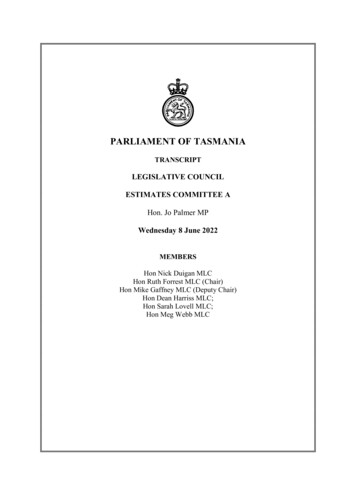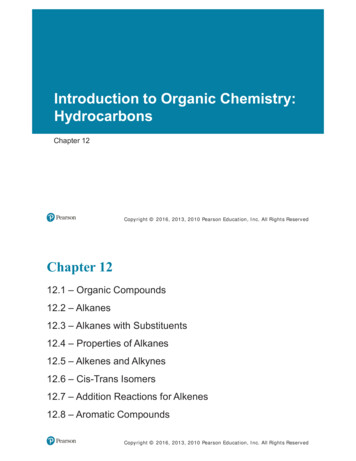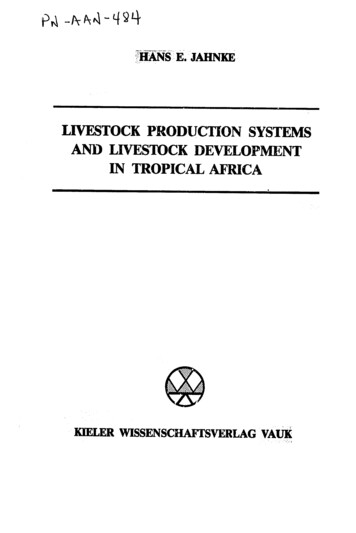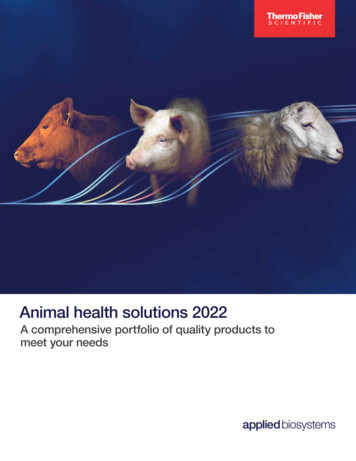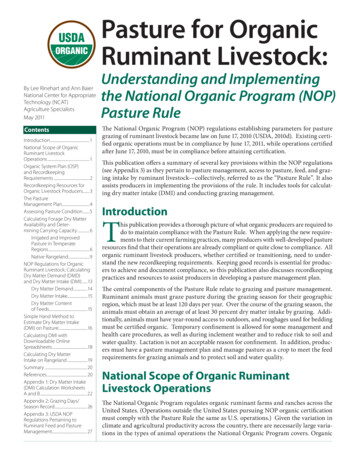
Transcription
Pasture for OrganicRuminant Livestock:By Lee Rinehart and Ann BaierNational Center for AppropriateTechnology (NCAT)Agriculture SpecialistsMay 2011ContentsIntroduction.1National Scope of OrganicRuminant LivestockOperations .1Organic System Plan (OSP)and RecordkeepingRequirements .2Recordkeeping Resources forOrganic Livestock Producers .3The PastureManagement Plan.4Assessing Pasture Condition .5Calculating Forage Dry MatterAvailability and Determining Carrying Capacity .6Irrigated and ImprovedPasture in TemperateRegions .6Native Rangeland .9NOP Regulations for OrganicRuminant Livestock; CalculatingDry Matter Demand (DMD)and Dry Matter Intake (DMI) .13Dry Matter Demand .14Dry Matter Intake.15Dry Matter Contentof Feeds .15Simple Hand Method toEstimate Dry Matter Intake(DMI) on Pasture.16Calculating DMI withDownloadable OnlineSpreadsheets.18Calculating Dry MatterIntake on Rangeland .19Summary . 20References. 20Appendix 1: Dry Matter Intake(DMI) Calculation WorksheetsA and B . 22Appendix 2: Grazing Days/Season Record . 26Appendix 3: USDA NOPRegulations Pertaining toRuminant Feed and PastureManagement. 27Understanding and Implementingthe National Organic Program (NOP)Pasture RuleThe National Organic Program (NOP) regulations establishing parameters for pasturegrazing of ruminant livestock became law on June 17, 2010 (USDA, 2010d). Existing certified organic operations must be in compliance by June 17, 2011, while operations certifiedafter June 17, 2010, must be in compliance before attaining certification.This publication offers a summary of several key provisions within the NOP regulations(see Appendix 3) as they pertain to pasture management, access to pasture, feed, and grazing intake by ruminant livestock—collectively, referred to as the “Pasture Rule”. It alsoassists producers in implementing the provisions of the rule. It includes tools for calculating dry matter intake (DMI) and conducting grazing management.IntroductionThis publication provides a thorough picture of what organic producers are required todo to maintain compliance with the Pasture Rule. When applying the new requirements to their current farming practices, many producers with well-developed pastureresources find that their operations are already compliant or quite close to compliance. Allorganic ruminant livestock producers, whether certified or transitioning, need to understand the new recordkeeping requirements. Keeping good records is essential for producers to achieve and document compliance, so this publication also discusses recordkeepingpractices and resources to assist producers in developing a pasture management plan.The central components of the Pasture Rule relate to grazing and pasture management.Ruminant animals must graze pasture during the grazing season for their geographicregion, which must be at least 120 days per year. Over the course of the grazing season, theanimals must obtain an average of at least 30 percent dry matter intake by grazing. Additionally, animals must have year-round access to outdoors, and roughages used for beddingmust be certified organic. Temporary confinement is allowed for some management andhealth care procedures, as well as during inclement weather and to reduce risk to soil andwater quality. Lactation is not an acceptable reason for confinement. In addition, producers must have a pasture management plan and manage pasture as a crop to meet the feedrequirements for grazing animals and to protect soil and water quality.National Scope of Organic RuminantLivestock OperationsThe National Organic Program regulates organic ruminant farms and ranches across theUnited States. (Operations outside the United States pursuing NOP organic certificationmust comply with the Pasture Rule the same as U.S. operations.) Given the variation inclimate and agricultural productivity across the country, there are necessarily large variations in the types of animal operations the National Organic Program covers. Organic
ruminant farms include sheep and goat farms, dairy farms, and beef cattle farms andranches, and any other ruminants raised organically for meat, milk or fiber (i.e. bison,llamas, deer, etc.). Aside from these differences, there are also variations in pasture productivity. For example, dairy and beef farms in New England, the mid-Atlantic, the upperMidwest, the deep South, the Pacific Northwest, and some parts of the West are characterized by adequate precipitation that fosters the use of intensive grazing systems such as rotational grazing. Beef cattle and small ruminant ranches in the semi-arid western regionsof the United States are typified by less precipitation, shallower soils, and slower nutrientcycling on pastures. Grazing operations in these regions range from rotational systems tocontinuous grazing on rangeland.It is important to note that the NOP Pasture Rule was developed to encompass all types ofoperations and regions of production. Whether a dairy grazier in Pennsylvania or a beefrancher in Arizona, this publication will help producers maintain compliance with thePasture Rule.Organic System Plan (OSP) andRecordkeeping RequirementsUnder the NOP regulations, every certified organic livestock farm or handling operationmust submit an Organic System Plan (OSP) when applying for certification and update thatplan annually (or more frequently if operational changes are made). A well-prepared planand detailed records make inspections much easier, and allow the producer to conduct ayearly audit of his or her plan and make changes where necessary. The NOP regulationsoutline the specific requirements for a complete OSP. In addition, the publication OrganicSystem Plan (OSP) Templates for Certifiers discusses OSP requirements in detail througha form that is used by many certifiers. This publication focuses only on the OSP requirements as they pertain to the Pasture Rule.The following need to be described or addressed in the Organic System Plan: Management of pasture to provide sufficient forage quality and quantity to grazethroughout the grazing season Description of all feeds (including pasture) and supplements for each type and classof animal, including source, percentage and amounts fed, and changes to rations A grazing season specific to the geographical region, of a minimum 120 days(breaks from grazing are permitted during the grazing season; the grazing seasonmay be non-continuous) Dry matter intake of at least 30 percent from vegetation rooted in pasture or residual forage (forage cut and left in the pasture for grazing) during the grazing season Method for calculating dry matter demand and dry matter intake for feeds andpasture Sources of values for animal daily dry matter demand and dry matter content offeeds fedPage 2www.ams.usda.gov/nopPasture for Organic Ruminant Livestock
Length of Grazing SeasonThe grazing season must be at least 120 days long within each 1-year period. Organic producersshould strive to maximize the number of days their animals are on pasture. The intent of the PastureRule is to ensure that organic ruminant operations are pasture-based systems, as well as to increasepasture productivity and pasture quality over time.The grazing season should be determined by the producer and verified by a certifying agent on thebasis of site-specific conditions and the typical grazing season timeframes for the region in whichthe farm is located. The expected grazing season must be documented in the Organic System Plan.Certifiers will review the OSP and verify that the planned grazing season is adequate. In any givenyear, however, the actual length and timing of the grazing season could vary from the grazing season described in the OSP. For instance, if producers within a region are generally able to graze bythe first of May and the grazing season normally ends in mid-October, then the planned grazingseason described in the OSP would be 168 days for a farm in that vicinity. During a year in whichspring arrives early, however, a producer may let the livestock out to pasture in mid-April. The nextyear could bring a late spring during which wet soil conditions may keep the animals off pastureuntil mid-May. Although the actual grazing start dates are variable given the environmental conditions of a specific year, the OSP could continue to describe the start of the grazing season as May 1.The dates of the actual grazing season will be recorded in the producer’s records (see Appendix 2for a sample form). Organic inspectors will review the records of the actual grazing season on-siteso that the certifier can determine compliance with the requirement to provide pasture for grazingthroughout the grazing season.Remember, the grazing season need not be continuous. For example, a producer might get 90days of grazing from April to July, then remove animals from pastures during a 2-week summerslump period. Grazing could then resume in late July or August for 60 to 90 days until frost. It isimportant to remember that grazing conditions are very site specific. In addition, the grazing season may be extended through various strategies, such as stockpiling forage in place on pasture forwinter grazing. Specifically, this strategy might be successful in the Midwest with fescue pastures,in the Northern Plains and Intermountain West with forages such as Altai wildrye, and in the humidSouth with bermudagrass.Recordkeeping Resources for OrganicLivestock ProducersRecordkeeping is a critical component of organic production, and the new Pasture Rulerequires that organic livestock producers maintain feed and pasture records. Records demonstrate implementation of the pasture management plan. They can also help producerslearn from tracking their own observations and practices systematically, and improve theirproduction systems. A good resource for recordkeeping is the publication Organic LivestockDocumentation Forms, available online at www.attra.ncat.org/attra-pub/livestockforms.htmlor by calling 800-346-9140. Appendix 2 provides an excerpt from this publication.Slaughter Stock Production ExemptionRuminant livestock that are raised for slaughter must be maintained on pasture during the finishingperiod when that period overlaps with the grazing season. However, slaughter stock are exemptfrom the 30% dry matter intake from grazing pasture requirement during the finishing period.The finishing period may be a maximum of 120 days or one-fifth of the animal’s life, whichever isshorter. Outdoor access must be provided during the finishing phase, and feedlots or yards mustbe of ample size to allow adequate animal movement without crowding and without competitionfor food. In summary, dry matter intake from pasture does not have to be calculated for ruminantslaughter stock during the finishing period. And, when the finishing period coincides with the grazing season, slaughter stock must have pasture access.Understanding and Implementing the National Organic Program (NOP) Pasture RulePage 3
The Pasture Management PlanOrganic ruminant livestock producers must include a pasture management plan with theirOSP. The plan should document the management practices used to provide quality forage for the grazing season. Maintaining sufficient quality and quantity of pasture to grazethroughout the grazing season can be accomplished by understanding how much forageis available, how much forage the livestock will consume, and matching the two to usethe pasture resource most efficiently. Some simple measurements and calculations, pasture maps, and a record of days grazing each pasture are all that is needed. Certifiers mayaccept an estimate of available forage in lieu of calculations. However, taking forage measurements and documenting forage supply and demand will help producers to determinepasture or paddock size and length of grazing period. Good management and a pasturemanagement plan can improve pasture productivity and utilization.The Pasture Management Plan (part of the Organic System Plan) should describe the following practices: Types of pasture: plant species, perennial pastures, annual pastures, etc. Pasture management practices to maintain pasture quality and at least 30% drymatter intake (DMI) from grazing Length of grazing season Grazing system used: rotational, high-density, rest-rotation, etc. Locations and types of fences, shade, and water Soil fertility plan How forages and forage crops are seeded Erosion control practices used to protect soil and water qualityGrazing Management Resources for Planned GrazingThe Grazing Systems Planning Guide developed by the University of Minnesota Extension Serviceis a good resource for developing a grazing system plan. It is available online at s/DI7606.html or by calling 800-876-8636.Other resources to help develop a grazing system:Temperate and Introduced PasturesPastures for Profit: A Guide to Rotational Grazing, University of Wisconsin niversity of Kentucky Cooperative Extension Rotational Grazing versity of Vermont Pasture Networkwww.uvm.edu/ pasture/Dairy & Livestock Resources, Northeast Organic Farming Association of angeland and PastureGrazing Lands Technical Publications, USDA Natural Resources Conservation ServiceGrazing Lands Technology ions/index.htmlPasture and Grazing Technical Information & Tools, Michigan ludes excellent resources for writing a pasture management plan.continued on page 5Page 4www.ams.usda.gov/nopPasture for Organic Ruminant Livestock
Holistic Management Internationalwww.holisticmanagement.orgEducational workshops and tools, including publications and worksheets for holistic ranch management and grazing planning.The following ATTRA publications are particularly useful in designing grazing systems:Rotational Grazing IP086Paddock Design, Fencing and Water Systems for Controlled Grazing IP152Assessing Pasture ConditionOrganic livestock producers strive for continual improvement of their pastures. Underorganic management, producers should notice pastures becoming not only more productive but also more resilient to fluctuating environmental situations.Producers can realize continuous pasture improvement by implementing a grazing systemthat rations out forage according to animal requirements, allows for full plant recovery, andminimizes forage waste (Murphy, 1995). The elements of a sustainable grazing system are: timing of grazing (corresponding to plant physiological stage) intensity of grazing (duration on the pasture) assessment of residue or plant height after grazing allowing for plant recovery time after grazing adaptive management of grazing practices, depending on pasture recovery rates(i.e., grazing time on a pasture may increase during less-productive times of theyear to allow for more plant recovery time after grazing)The goal of organic pasture management should be the continual improvement of the following ecological characteristics, which can easily be assessed by observing pasture growthand plant recovery throughout the grazing season and over several years of organic management: High leaf-area index—an increase in the leaf-to-land-area ratio in the pasture; thisis a measure of the amount of vegetative plant cover as a proportion of the overallarea of a given part of the pasture. High plant density/close plant spacing—related to leaf-area index; soil structureimproves and forage plants become healthier; tillering is encouraged throughgrazing management, and bare soil is reduced. High plant diversity and pasture complexity—more plant species begin to occupythe pasture; pasture species complexity allows for greater resilience from environmental pressures. Plant growth throughout growing season—plants stay vegetative longer andbecome more competitive, producing a pasture of higher quality for a longer grazing season. Decrease in unproductive plants (over-mature, stunted, weeds) —grazing selectivity is decreased, especially through high-density grazing, and plants are grazedbefore they become unpalatable. More perennial plants—plant succession tends toward perennial plants withdeeper root systems; this allows for better soil conditions and fosters vegetativereproduction in some forage-plant species.Understanding and Implementing the National Organic Program (NOP) Pasture RulePage 5
Resources for Assessing Pasture Health and ProductivityThe USDA Natural Resources Conservation Service (NRCS) publication Guide to Pasture ConditionScoring (Cosgrove et al., 2001) lists several key indicators for assessing pasture health and resiliency.Some of the indicators to observe and track include: percent desirable plants, plant residue, plantdiversity and vigor, insect and disease pressure, percent legumes in the pasture, and soil fertility andcompaction. Producers can use these indicators to assess how well they are managing their pastures.The Guide to Pasture Condition Scoring has an accompanying Score Card that producers can use toevaluate their pastures. These materials are available from local USDA NRCS Service Centers, or canbe downloaded from the NRCS website at x.html.The Jornada Experimental Range, a USDA-Agricultural Research Service activity in Las Cruces,New Mexico, offers detailed publications on rangeland monitoring and health assessment. Thesematerials are available for download at http://usda-ars.nmsu.edu/monit assess/monitoring.php.Calculating Forage Dry Matter Availabilityand Determining Carrying CapacityThe term “pasture” encompasses many different types of forage-based systems that supportgrazing by livestock. These span extensive, native range to seeded, fertilized and irrigated“improved” pasture.Determining how much forage is available (forage yield available for grazing) in a particular pasture is crucial to meeting the needs of grazing animals. Calculating forage dry matter availability helps allocate forage resources for the duration of the grazing season andaids producers in complying with recordkeeping requirements. According to the PastureRule, producers must manage pasture as a crop and submit a pasture management plan.This plan includes documentation of the management practices used to provide pastureof a sufficient quality and quantity for livestock throughout the grazing season in order toobtain, at minimum, an average of 30% dry matter intake from pasture.Forage yield determinations first start with observation. Weekly or daily pasture walkscan bring trouble spots to the producer’s attention. Differences in soil types and animalbehavior (such as congregating in one area) often result in wide variations in forage yieldand utilization across any given pasture. Awareness of trouble spots helps to direct management practices to those areas and enables producers to assess more accurately the actualforage yield across the pasture.Irrigated and Improved Pasture in Temperate RegionsThe factors to consider in determining forage yield for temperate pasture include forageheight, density, maturity, and plant species composition. A forage stand should be dense,not overly mature, of appropriate height before grazing, and diverse in plant species. Producers who walk their pastures consistently have a keen eye for the health of the foragestand and learn to estimate forage yield by repeated observation. Walking pastures enablesproducers to encounter less-productive areas (and trampled areas) that are candidates forpasture improvement.An easy way to measure forage yield is with a pasture ruler. A pasture ruler is placed onend at ground level, with forage height measured in inches. Each inch of forage heightequals anywhere from 100 to 400 pounds per acre of dry matter, depending on the location,soil moisture, season of use, forage species, etc. Table 1 lists estimated pounds of forageavailable per inch for various temperate forages. Multiple measurements throughout thepasture should be recorded and averaged because not all areas of the pasture may grow orPage 6www.ams.usda.gov/nopPasture for Organic Ruminant Livestock
produce at the same rate and density. This method works well in the eastern and southernUnited States, and on irrigated pastures in the West, where soil moisture allows dense, vegetative forage stands. The pasture ruler method should be calibrated for local conditions byclipping and weighing forage samples (see below) to determine forage yield on a per-acrebasis. This combination will help improve accuracy in measuring forage yield with a ruler.Table 1: Pounds of forage available per inch(dry matter, eastern and southern United States)Forage speciesDry matter pounds/acre/inchAverageRangeAlfalfa and grass mixes22575-400Arrowleaf clover200100-300Bermudagrass260150-500Caucasian bluestem18075-350Crimson clover200100-300Kentucky bluegrass160100-175Native warm season grasses10050-250Orchardgrass18075-300Orchardgrass clover200100-300Red clover220100-300Annual ryegrass25075-400Oats, wheat, rye15075-250Tall fescue210100-350Tall fescue clover19080-325Source: Ball et al., 2006Clip and Weigh Forage Yield MeasurementTo determine annual plant productivity, a producer clips all the current year’s foragefrom within a 1.92 square foot quadrat and weighs the sample in grams. The quadrat isconstructed from PVC pipe and measures 11.5 inches by 22 inches. The quadrat is thrownrandomly on the ground, and all the current year’s forage inside the quadrat is harvestedwith shears or scissors. Th is sampling procedure is repeated at least 10 times to get arepresentative sample of the area.The weights of the samples (grams) are summed and multiplied by the percent dry matterof the forage that was harvested. Fresh vegetative forage in most improved pastures has amoisture content of 75 to 85%. Generally, the more mature a forage is, the less the moisture content. The dry matter forage weight is then multiplied by a conversion factor – inthis case, the conversion factor is 50 for a 1.92 sq.ft. quadrat. Multiplying the dry weightsof the forage in grams by 50 results in lb/ac yield, which is the forage dry matter yield forthe site sampled.More information on conducting a clip-and-weigh forage assessment is widely availablefrom Cooperative Extension services, as well as from ATTRA by calling 800-346-9140.Also, local NRCS staff or Cooperative Extension Agents usually have estimates of forageyield for specific locations.Understanding and Implementing the National Organic Program (NOP) Pasture RulePage 7
Determining Paddock Size and Carrying CapacityA paddock is a pasture subdivision in a rotational grazing system. Animals are movedperiodically from paddock to paddock to ensure the availability of high-quality foragefor the grazing animals while maintaining forage productivity. To best allocate forageresources, either the size of the paddock for a given number of animals—or conversely, thenumber of animals for a given paddock size—must be determined. Before determiningpaddock size, it is important to determine the amount of forage that is available for grazingin the paddock. Determining forage yield on a pound-per-acre/inch basis has already beenintroduced, and this is used to calculate grazable forage. Grazable forage is the forage thatwill be grazed, leaving a predetermined forage residue height after grazing.Once a determination of dry matter yield per acre/inch has been made, the height of theafter-grazing residue is subtracted from the total forage height. Then, the forage yield inpounds per acre/inch is multiplied by the difference in forage height to give the amount offorage available for grazing in pounds per acre. This is accomplished with the followingformula:Total forage height – Forage residue Grazable forage heightGrazable forage height x Pounds per acre/inch Grazable forage in poundsper acre (on a dry matter basis)Producers need to determine how to use this forage. Things to know include (1) the dailyforage dry matter demand (in lbs) of grazing livestock, (2) the number of days grazing eachpasture or paddock, and (3) the size of the pasture or paddock needed for a given numberof animals. To determine the daily forage dry matter demand (in lbs) of grazing livestock,use the following formula:Number of animals x Average animal weight x Percent dry matter intake (ora forage utilization measure) Daily forage demand (lbs) of grazing livestockNote: Percent dry matter intake is expressed as a percent of animal body weight, whichis a utilization value. For example, lactating dairy cattle consume between 2.5% and 4%of their body weight per day. Some producers choose to include in this utilization valuean account of forage wasted through trampling, etc. (usually about 0.5% of animal bodyweight). Therefore, forage utilization may include more than dry matter intake, to accountfor wasted forage.Determine the number of days animals can graze a paddock by using the following formula:Grazable forage in pounds per acre (dry matter) Daily forage demand (lbs)of grazing livestock Number of days grazing each paddockThe final thing a producer needs to do is determine the size of a pasture or paddock for agiven number of animals. Use the following formula:(Daily forage demand (lbs) of grazing livestock x Days in the grazing period) Grazable forage in pounds per acre (DM) Paddock size in acresResources that include worksheets for measuring forage availability and determining livestock forage demand are listed in the Assessing Pasture Condition section above.Page 8www.ams.usda.gov/nopPasture for Organic Ruminant Livestock
Paddock size and grazing period example: 1,150 lb lactating cowsAssumptions:50 lactating cows, average weight 1,150 pounds3.5% daily dry matter intake (as a percentage of body weight)Average forage height at the beginning of grazing – 10 inchesAfter-grazing forage residue height – 2 inchesAverage pounds of forage per acre/inch – 250 pounds (dry matter)Grazable forage height10 inches – 2 inches 8 inchesGrazable forage in pounds per acre (dry matter)8 inches x 250 lb/acre/inch 2,000 poundsDaily forage demand of grazing livestock (dry matter)50 x 1,150 lb x .035 2,012 lbs/dayNumber of days grazing each paddock2,000 lb 2,012 lb 1 dayPaddock size in acres2,012 lb x 1 2,000 1 acreLeaving adequate forage residue after grazing is vital to obtain sufficient forage re-growth,both vegetative and root growth, prior to the next grazing event. For more information,see the ATTRA publication Rotational Grazing available online at www.attra.ncat.org/attra-pub/livestockforms.html or by calling 800-346-9140.Optimum Post-Grazing Residue Heights for Selected ForagesCool-season perennial bunchgrasses – 3 inchesWarm-season perennial bunchgrasses – 6 inchesWarm-season annual grasses – 8 inchesCool-season annual grasses, including cereals – 3 inchesWhite Clover – 1 inchOther Clovers – 3 inchesTall Fescue – 2 inchesBermudagrass – 1 inchKentucky Bluegrass – 1 inchSource: Ball et al., 2006Native RangelandThe per-acre/inch forage yield assessments (as noted above) are seldom used on arid andsemi-arid rangeland. Instead, rangeland managers rely on such criteria as plant speciescomposition, frequency of key species, forage productivity (annual yield), and percentageof cover to get an overall assessment of the health of the whole rangeland ecosystem. Thisrangeland health assessment is useful for determining yield and livestock carrying capacityon rangeland. For detailed informational resources on rangeland health assessment andyield determination, see the accompanying box on Rangeland Resources.Rangeland ResourcesRangeland Health and Planned Grazing Field Guidehttp://quiviracoalition.org/Detailed/QC Publications/Field Guides/Rangeland Health and. 83.htmlAn introduction to planned grazing on arid and semi-arid rangelands.USDA-NRCS National Range and Pasture ons/nrph.htmlHow to Measure Forage Production For the Astute Producer, Texas nding and Implementing the National Organic Program (NOP) Pasture RulePage 9
Native rangeland annual productivity values can be obtained from the USDA NaturalResources Conservation Service Soil Survey. Each county in the United States has beenhistorically mapped according to soil type and native plant composition. Annual productivity values for each plant are also listed, including data for periods of below average annual precipitation, normal periods, and periods of high annual precipitation. It isimportant to remember that these values are for the native plant population historicallyassociated with these sites. Native vegetation on many rangeland sites across the westernUnited States has been replaced by introduced species such as crested wheatgrass or Oldworld bluestem that may yield more dry matter than the native plants. In addition, introduced noxious weeds such as knapweed and downy brome (cheatgrass) may also be present, which will further reduce
The fi nishing period may be a maximum of 120 days or one-fi fth of the animal's life, whichever is shorter. Outdoor access must be provided during the fi nishing phase, and feedlots or yards must be of ample size to allow adequate animal movement without crowding and without competition for food.
